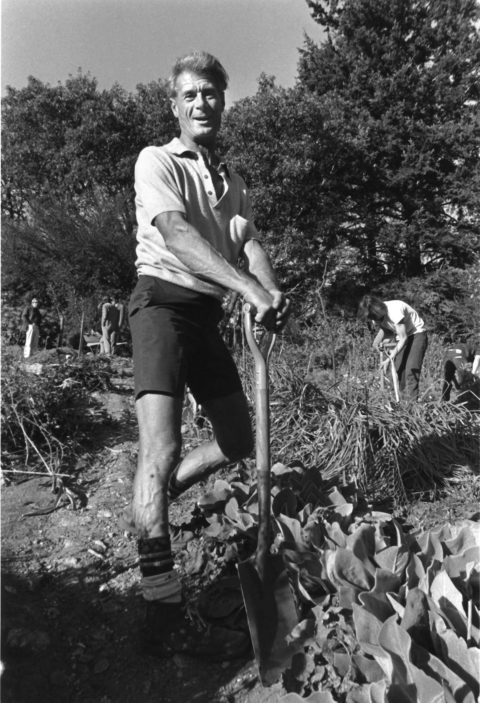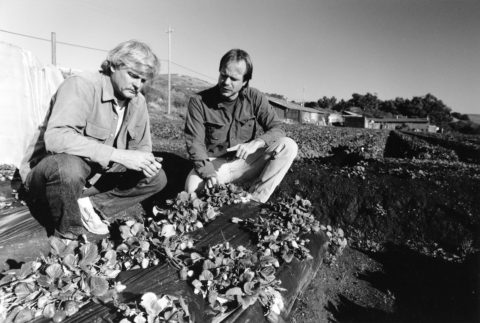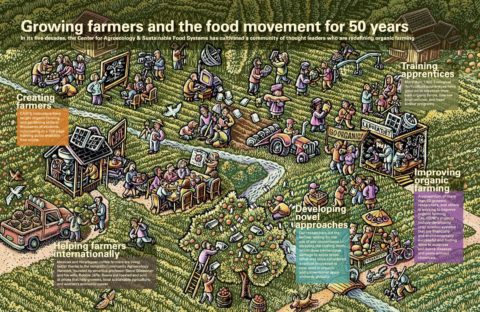Jim Cochran was standing on his Swanton Valley farm, pondering the organic strawberry plants at his feet, when his new neighbor, Steve Gliessman, approached.
Cochran was a maverick farmer who was fascinated by European intellectual history and Gliessman was a UC Santa Cruz plant ecologist who had recently started a program that combined ecology with agriculture, a science he called agroecology.
Over an old barbed-wire fence, the two men began talking about soil diseases, crop rotations, and how every expert and grower in California believed it was impossible to successfully grow organic strawberries.
Little did the two men know, but that 1986 conversation would start a revolution in strawberry farming that would prove the naysayers wrong and also launch one of the signature achievements of UC Santa Cruz’s Center for Agroecology & Sustainable Food Systems (CASFS), which this year celebrates its 50th anniversary.
Today, organic berries fill cases in stores like Safeway and Costco, and the number of acres of organically grown strawberries in California has risen from just 134 in 1997 to 2,989 in 2016.
The men’s meeting would also spark UC Santa Cruz’s reputation as the mothership of organic agriculture, a standing that continues with campus researchers still delving into new ways to fight agricultural disease and pests without using chemicals.
“It’s important to remember,” says Daniel Press, an environmental studies professor and executive director of CASFS, “that we had no business doing this.”
Seeds of change

Charismatic English master gardener, Alan Chadwick, created a beautiful organic garden on a hillside near Merrill College using what he called the biodynamic/French intensive method.
Every story should begin at its roots, and the rise of California’s organic strawberry industry has a crucial part of its origins with UC Santa Cruz and a charismatic English master gardener named Alan Chadwick. In 1967, Chadwick was recruited to create a place of connection for students on campus at a time when protests raged against the Vietnam War and the assassinations of Martin Luther King Jr. and Robert Kennedy would shortly rock the nation.
Surrounded by a crew of eager students, Chadwick soon created a beautiful organic garden on a hillside near Merrill College using what he called the biodynamic/French intensive method, which involved natural fertilizer and a lot of shovel work.
In the 1970s, students asked for a larger plot of land and were given 17 hidden acres on the lower part of campus. Chadwick had left by then, but acolytes continued his work. They plowed the soil with a pair of brother-and-sister draft horses. They planted rows of cypress as a windbreak and put up teepees for a burgeoning apprenticeship program.
By the early ‘80s, public concern over the impacts of conventional agriculture was on the rise, and Gliessman, recently returned from a stint farming and teaching in Mexico, was hired to expand the academic reach of the program. He turned the farm into an outdoor laboratory and classroom for teaching and studying the new science of agroecology.
He and other researchers began some of the first formal research on agroecological practices, including crop rotation and natural pest control, as a way to avoid agriculture’s increasing dependence on chemicals, an unsustainable system to their way of thinking.
“It was a nonconventional faculty that was barely tolerated by campus,” Press says, striding toward the university’s now-30-acre farm with its lush cover crops, blueberry canes, and humped rows of strawberries. “At best we were considered loopy and irrelevant. At worst, we were considered dangerous, subversive, and possibly illegal.”
All that would change.
The experiment
Strawberries are the princess-and-the-pea of crops. While economic royalty, strawberries also easily fall prey to a wide variety of insects and soil-borne pathogens, especially when they are raised in the same fields year after year.
Most growers used chemicals to protect the finicky plants, including the fumigant methyl bromide, which wiped out soil diseases so effectively berries could be raised on the same plot of land without interruption. But environmental and health concerns caused a phase-out and ban of the fumigant with a deadline of 2017.
Cochran, who’d been sickened by an accidental pesticide exposure while working for a farmworker-owned strawberry cooperative, decided to give organic berry farming a try in 1983.
Three years later, he was standing in his field scratching his head over his plants when Gliessman came along.

Grower Jim Cochran (left) and Sean Swezey of the Agroecology Program (now CASFS) examine strawberry plants in 1989 at a “conversion study” plot in Davenport, California, where conventionally farmed land was converted to organic production.
By 1987, the two men had set up a series of experimental plots on three acres of North Coast land, a project funded by UC’s newly established Sustainable Agriculture Research and Education Program designed to meet the needs of small-scale farmers, farmworkers, and alternative-farming systems.
“Steve said, ‘Let’s set up a demonstration project and try to understand the soil biology and insect ecology here,’ and that was brilliant,” Cochran remembers, “because it really provided the scientific underpinnings that would be able to transform the industry.”
For instance, the conventionally grown strawberries would be sprayed with a miticide to rid the plot of the destructive two-spotted spider mite, while a host of beneficial predator mites would be loosed in the organic berries to fight the same pest and the results recorded.
When the strawberries began suffering because repeated plantings caused soil-borne pathogens to rise, the two men experimented with crop rotations, discovering, for instance, that broccoli helped get rid of the disease organisms that so damaged the berries.
Over time, the organic strawberries thrived. The conventional berries seemed slightly larger but the organic fruit tasted great, the yield was high, and Cochran made money because he could sell the organic berries for a higher price. People began to notice.
“In fact, it was going so well, people accused us of falsifying data,” says Gliessman who said it took six years of analyzing and resubmitting data before his first study was finally published by a scientific journal.
Gliessman and other UC Santa Cruz researchers took their work into the farming community, and, because demand for organic produce was growing and the deadline to phase out methyl bromide was set, growers listened.
Today, thanks to many of the methods pioneered by Cochran, Gliessman, and other UC Santa Cruz researchers, more than 10 percent of the state’s multi-billion-dollar strawberry crop is organic, according to the California Strawberry Commission. Even large-scale growers are turning toward more sustainable strawberry-growing practices.
“A lot of scientists go on with the existing paradigm and do what everybody else is doing and don’t rock the boat because that’s the way you get promotions and get published,” says Cochran as he drives his dusty SUV toward his 12-acre organic farm north of Davenport. “Steve took the opposite route of going in an entirely different direction.… He’s sort of emblematic of the rogue scientist who ends up discovering something important.”
Still at work
If being different marked the early years of agricultural research at
UC Santa Cruz, thinking outside the box continued to be the hallmark of the campus.
For instance, UC Santa Cruz entomologist Sean L. Swezey, working with researchers Diego Nieto and Janet Bryer, found a method for controlling the pesky lygus bug. Using the fields of grower Larry Eddings, they discovered that if a grower replaced every 50th row in a strawberry field with alfalfa—a crop that attracts lygus insects like gamblers to a Las Vegas buffet—and then used a vacuuming machine to suck the bugs from the alfalfa, the pests could be greatly reduced without the use of chemicals.
Meanwhile, around 2002, environmental studies professor Carol Shennan, then-director of the Center for Agroecology & Sustainable Food Systems, noticed that, despite using crop rotations, the strawberries on campus were again falling prey to the damaging soil pathogen, Verticillium dahliae.
A friend of Shennan’s, a Dutch plant pathologist, saw the listless berry field and described a process called Anaerobic Soil Disinfestation, or ASD, that seemed a promising solution but said no one seemed willing to test it.
Shennan began thinking.
She turned to her colleague, associate researcher Joji Muramoto, and asked him to help set up a small ASD experiment on the UC Santa Cruz Farm.
ASD involves putting a carbon source like chopped cover crops or rice bran or even molasses into the soil. The ground is then irrigated and covered with plastic, which sparks decomposition by soil microbes that can thrive without oxygen, producing various organic acids that are toxic to the pathogens. It’s tricky business, needing the right temperature, water, and soil amendment to work.
“It took us a few years to figure out how to do it,” Muramoto says of the project, which was funded by the U.S. Department of Agriculture and the California Strawberry Commission.
Today, 1,400 acres of strawberries and raspberries are being grown using ASD, up from one acre only five years ago. Shennan and Muramoto, meanwhile, are preparing a guide that will spell out specific guidelines for ASD use in different areas and for different crops.
“We were at the right place at the right time,” Shennan says. “And I do think part of it was being at UC Santa Cruz. We would try things that were outside of the box in a way that people at the ag campuses didn’t. They were doing things their own way and had been working with fumigants for years but hadn’t really considered looking at nonfumigant options.”
On the farm
Rod Koda’s 23-acre strawberry farm near Watsonville has a million-dollar view of the Monterey Bay. He’s worked this plot of land since 1985, following in the footsteps of his late father-in-law, Kuni Shinta.
In 2006, he heard Shennan and Muramoto give a presentation on ASD and decided to give the technique a try on his own nine acres of organic fruit. The process, he says, netted 800 to 1,000 more trays of strawberries per acre—although with rising costs and falling prices, organic berries can still be a complicated business.
Meanwhile, UC Santa Cruz researchers are still at work trying to help farmers like Koda find more, and still profitable, alternatives to chemical use in agriculture.
“Looking back, I can see how each thing I did led to the next, but the whole thing never could have been planned,” says Gliessman. “I always tell my students that as long as it feels like the right thing to do, you should do it. Don’t be afraid to take a risk. Hold onto an ideal and then go for it.”


